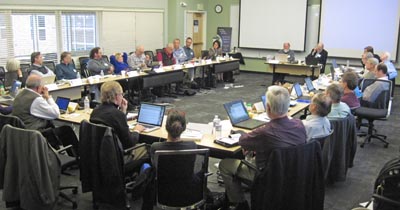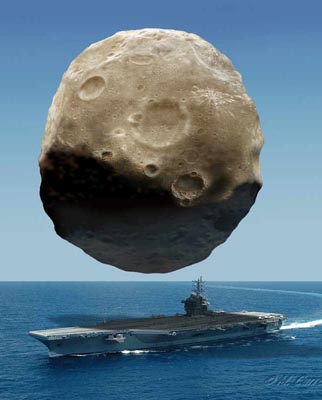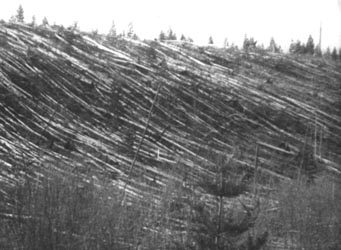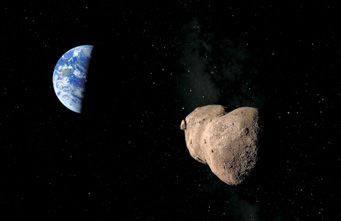As the opening credits roll in the 1998 disaster flick Armageddon, an amateur observer with some serious gear discovers an asteroid the size of Texas (visually!) and immediately calls it in to NASA. That phone call is about the only remotely true-to-life astronomical scene in the movie. The rest of it is, well, entertaining.

A group of scientists, policy-makers, and science journalists discuss communication strategies that will be most effective should astronomers discover an asteroid or comet on a collision course with Earth.
J. Kelly Beatty
But this past week about 30 impact scientists, communications professionals, policy-makers, social scientists, and science reporters came together in Boulder, Colorado, to explore the "what ifs" were a near-Earth object (NEO) to threaten Earth for real.
This diverse group had been assembled by the nonprofit Secure World Foundation on behalf of "Action Team 14," a sub-subcommittee of the United Nations' Committee on the Peaceful Uses of Outer Space (COPUOS). Through AT-14, COPUOS members have been working for several years on the blueprints for an Information, Analysis, and Warning Network — the policies and procedures that would guide world governments and their respective first-responders when and if we learn that a cosmic collision is coming.
This might surprise you, but there is no worldwide disaster-notification protocol of any kind. The closest analogy might be the cooperative early-warning system developed for tsunamis in the wake of the devastating inundation of Sumatra in 2004. But even that falls short of what's really needed, according to a recent assessment.

When the 400-m-wide asteroid 2005 YU55 cruised past Earth last week, reporters repeatedly referred to it as "the size of an aircraft carrier" — even though few of us have a true sense of how big that is.
As it happens, November 8th's flyby of the 2005 YU55 served as a backdrop for the workshop's discussion. Dynamicists have long known that this visit would result in a clear miss, and the event was popularized more for the prospect of just watching it go by than out of nervous concern that dynamicists has somehow grossly miscalculated. Given the great number of close approaches by asteroids in the recent past and future, it seems that the news-media-stoked sensationalism so rampant in past years has quieted.
Still, how should the word get spread, among governments and to the public, on that certain someday when astronomers realize that a sizable space rock has Earth in its crosshairs? That's what the workshop's attendees (yours truly among them) grappled with for two days. We didn't come to any particularly profound conclusions, but we did frame the guidelines for some commonsense responses.
The first thing to appreciate is that although Earth has been and will get clobbered, it doesn't happen very often. Impacts from objects 10 km across, energetic enough to sterilize Earth, or nearly so, are once-per-100-million-year events — a good thing!

Trees near the Podkamennaya Tunguska River in Siberia still looked devastated nearly two decades after a large meteorite exploded above the ground in June 1908. The Tunguska event, which ranks as one of the most violent cosmic impacts of this century, leveled nearly 800 square miles of forested taiga.
Smithsonian Institution
Far more likely, occurring perhaps once every 500 years, would be getting hit by something close to 100 feet (30 m) across. That's small in the pecking order of asteroids but still big and energetic enough to cause absolute destruction to a localized area without ever reaching the ground. We actually know about one such event: in 1908, an object of this size exploded in midair over Siberia and managed to decimate a huge tract of wilderness.
"It is virtually certain (probability > 99%) that the next destructive NEO event will be an airburst," asserts Mark Boslough, who models the destructiveness of impacts at Sandia National Laboratories.
The second take-away is that we'll likely have considerable forewarning — years or even decades in advance of a collision. Sure, it's still possible that we'll be blindsided. Three years ago, 2008 TC3 slammed into the atmosphere over Sudan just 19 hours after its discovery. There wasn't much time to react, but we lucked out because it was no bigger than a car.
Third, the difficulty of pinning down orbital motion accurately means that impact predictions are fraught with uncertainty — and the public doesn't have much patience for uncertainty. An asteroid (or comet) that might seem threatening when first discovered will, almost always, prove harmless after further observation. So will everyday citizens grow tired or indifferent to repeated "false alarms"?

On Friday the 13th in April 2029, a 1,000-foot-wide asteroid named Apophis will pass close enough to Earth (within 20,000 miles) to briefly appear as a 3rd-magnitude star in the night sky.
Dan Durda
Even though a devastating impact is a low-probability event, the workshop's risk-management specialists — social scientists, not physical scientists — emphasized the need to have well-constructed, well-scripted, and well-rehearsed plans in place that cover everything from damage estimates to notifying the public to wholesale evacuation if necessary. Clear, consistent messaging is a must, as is transparency. None of that "disaster handbook" exists yet, but Sergio Camacho, who heads U.N. assessment, wants to pass on recommendations by 2013.
For more perspectives on the workshop and how we might prepare for a modern-day Big Bang, check out the postings offered by MSNBC's Alan Boyle, by risk specialist David Ropeik, and by planetarium-show producer Carolyn Collins Petersen. As always, feel free to offer your take on all this in the comment area below.
 16
16









Comments
Anthony Barreiro
November 18, 2011 at 2:50 pm
I have a hard time understanding why anybody would lose sleep over the prospect of an asteroid or comet hitting the Earth. If it's gonna happen, it's gonna happen, and there's not a whole lot we can do about it. Meanwhile people take all kinds of preventable risks every single day, from driving automobiles to eating too much sugar and fat and not getting enough exercise. And we are spewing carbon dioxide and other pollutants into our environment at a prodigious and increasing rate, killing off uncounted numbers of species every year, and endangering our own survival. In the immortal words of Pogo, we have met the enemy and he is us. Space rocks are way down on my list of worries.
You must be logged in to post a comment.
doug
November 18, 2011 at 2:55 pm
if there really is NOTHING that can be done if an significant impact is imminent, what is the big deal? Maybe jump into my personal mach 5 jet and live a few more moments....really what could be done of ANY relevance or benefit if a major impactor was on it's way? A small impactor, at great distance would allow for a few select to move out of harms way, but who decides who is worthy to escape? To make an issue out of "what can be done" seems to be an inefficient use of time and resources. News of a large imminent impact would not cause panic, it would cause chaos & crime as people would rationalize no repercussions for such action. Then if the impactor misses, what would remain of sanity? This "what if" debate should be a non-issue. Maybe if the dinosaurs had of discussed this and passed the right legislation...
You must be logged in to post a comment.
Thomas
November 18, 2011 at 5:10 pm
Dwight David Eisenhower (General and President of the US) once said:
“In preparing for battle I have always found that plans are useless, but planning is indispensable.”
Planning forces us to think, something which many do with great difficulty. This thinking, planning, and communicating our ideas strategy gives us alternative behaviors to use instead of a panic instinct. Because we formulate plans we have opened our minds to these alternatives and if the disaster does occur and none of plans fit, we will at least have developed the mental capacity to respond intelligently.
Another quote is in order here as well:
"Great minds discuss ideas. Average minds discuss events. Small minds discuss people." Eleanor Roosevelt
You must be logged in to post a comment.
Justin
November 18, 2011 at 5:41 pm
Certainly there is no one-size-fits all strategy here. A dinosaur-killer size impactor might cause a nuclear winter-like effect that could be survived by humans, plans and animals underground in a sort of "ark". In a few years, after the air cleared enough to grow plans again, the people could emerge and restart civilization.
Smaller, localized impacts could be handled in ways similar to hurricane or tsunami evacuations. Provide evacuation routes to other areas, and educate the public what to do.
Of course, if a worldwide sterilization level event occurs that burns the air and boils off the oceans, well there wouldn't be much to do but say our goodbyes.
With enough warning and planning, we could probably even deflect smaller size impactors by using some sort of ion powered rocket pack or some such. With enough warning, a fraction of a degree would mean the difference between an Earth impact and a harmless fly by.
You must be logged in to post a comment.
Tom
November 18, 2011 at 6:12 pm
There has been an increasing obsession over the past 50+ years to provide more and more information on many subjects to the people. While most of this has been helpful, some is not helpful. The prediction of theimpact of a large asteroid in the future would not be helpful farther than 7 days out or less. This is the question the group needs to tackle--when and how much information to give? Would it be better to give no information at all? The trend has been to give the public all available information (i.e., in medical care) even if there is nothing that can be done. I think it is unethical to destroy hope.
You must be logged in to post a comment.
Frank Reed
November 18, 2011 at 6:41 pm
A couple of commenters have suggested that there's nothing we can do... But there is. Even if you only have 50-100 hours notice of a Tunguska type impact, that advance notice will almost certainly pin down the threatened area with considerable accuracy. So you issue an evacuation order: everybody, get the hell out of anywhere within 20 miles of point "X". Now there is a very small chance that point "X" will be a major city, but if you throw darts at the Earth, you'll find that you hit water or nearly empty wilderness of low population agricultural areas 99% of the time. The difficult question for disaster planning is whether you issue the evacuation order when the uncertainty in the impact area is hundreds of miles (which would potentially kill more people in a panicked evacuation than the actual impact) or do you wait until the uncertainty is ten miles? And as noted by Kelly Beatty in the article, a Tunguska-size impact is by far the most probable impact disaster that we will have to deal with. Impacts which could not be managed by evacuation are exceedingly rare.
You must be logged in to post a comment.
Frank Reed
November 18, 2011 at 6:50 pm
Thomas, you posted a quotation from Dwight Eisenhower and another attributed to Eleanor Roosevelt. The latter is almost certainly misattributed: it was a bit of common pithy wisdom from the 1930s which became attached to Roosevelt's name about twenty years ago. The Eisenhower quote is certainly close to what he said in his second inaugural address, but referred to it as words of wisdom that he had learned long ago in the Army (just minor trivia of course). That said, the idea is a brilliant one: planning gets you thinking about the right range of possibilities but when the unthinkable happens, it probably won't fit your plans at all.
You must be logged in to post a comment.
G. Martin
November 19, 2011 at 8:36 am
Was there no discussion at the conference of using our rocket technology to divert an incoming impactor?
Of course, we would need to have the rockets already built -- there may not be enough time between discovery and impact to design and build an appropriate craft, especially if the object is a comet.
True, the chances of a major impact are slim. Nonetheless, the consequences of inaction are so great that it is imperative that we plan now to do everything in our power to avoid an impact.
We are the first life form on this planet to have the capability to avoid our own extinction from a cosmic impact. What a shame if we don't!
You must be logged in to post a comment.
Tree of Life ©
November 20, 2011 at 1:43 am
Why would it be impossible or unfeasible to watch Earth's path ahead of us as we travel through space? We do that all the time as we are driving each our various cars and other travel devices upon the roads all over this planet, don't we?
We have "road maps" of space with reasonably good resolution, for instance in the form of such astronomy software as Starry Night, Sky View Café, and Sky Charts, not to mention such tools as are available to us through NASA and JPL etc.. Using those tools for looking ahead we know when and where we are passing through the Saturn like rings of dust around the sun that are continuously being spawned by the various comets along their paths of travel.
Those Saturn like rings of dust around the sun are not much different from the intersections that we pass so many of along each our roads of traveling. Knowing fairly accurately not only the paths of those comets, and of the dust and of the variously sized rocks within those cometary paths, we also know quite accurately the speed and direction of the traffic traveling along those cross roads in the sky ahead of us...
It would seem an easy matter to direct our very best telescopes, e.g. the Hubble, towards those small portions of the cross roads ahead of us where such travelers must be located that are on a collision coarse with the Earth...
By knowing ahead of time pretty much exactly where in space to focus our attention it obviously becomes much more feasible to find the proverbial needle in the haystack and then to take care of that needle by reasonable means and such that we do not have to step on a rusty nail and get seriously hurt...
Praise the Lord of Hosts for providing for each and all of us all the necessary means for traveling safely through life and space under His guidance!
You must be logged in to post a comment.
Phil
November 20, 2011 at 10:45 am
If a relatively small impact in a very definite area is predicted, you could talk about giving warning and evacuating people. For large impacts and/or large uncertainties: don't bother. Either it will do no good (most/all of us will die anyway), or the panic and violence and traffic pile-ups will do in more people than the impact. Remember Houston trying to evacuate before Hurricane Rita? And if there's a fair chance of a large rock cleanly missing us, better to keep quiet than to gain a Chicken Little reputation should it miss us. The next time around, any warnings would be ignored.
Of course, the ability to deflect or break up into little pieces an asteroid or comet, so that we don't take a major hit in the first place, would be a far more productive use of resources than planning warnings and evacuations.
And a final note to "Tree"... our Solar System is a three-dimensional pinball machine, with large rocks careening in all directions. Merely "watching the road in front of us" would do very little to discern hazards, as we could get hit from any direction. This stuff isn't just sitting there, waiting for us to blunder into it.
You must be logged in to post a comment.
Grant
November 20, 2011 at 4:27 pm
This isn't news and no respectable astronomer/physicist would quote Armageddon. "Deep Impact" was far more believable and still managed to hit the nail pretty much on the head.
Odds are, any such perturbed body is going to come at us from the sun side (biggest perturbing body in the solar system?) and we'd have insufficient time to avert impact.
If it happens, if happens, C'est la vie (or morte!).
You must be logged in to post a comment.
Josh
November 20, 2011 at 9:55 pm
Well yes I do agree that there probably would not be to much time to act, but why not do everything in our power to divert/break-up a potentially world ending impact. I mean what would we have to lose if the result is going to be an extinction event anyways.
You must be logged in to post a comment.
Tree of Life ©
November 21, 2011 at 3:08 pm
Thanks Phil, for pointing out that, as you say, "our Solar System is a three-dimensional pinball machine, with large rocks careening in all directions..." However, I cannot agree with you that "Merely 'watching the road in front of us' would do very little to discern hazards..." Think about it! No doubt better than 999 out of a 1000 meteorites belong to, and are identifiable in terms of, relatively well known and charted cometary paths. The speed and the paths of each of those identifiable meteorites are known ahead of time, and if you consider any given such meteorite while taking advantage of the currently available astronomy software, you can easily figure out where in space that meteorite was located a week, or a month, or a year before impact....
You must be logged in to post a comment.
Tree of Life ©
November 21, 2011 at 3:25 pm
Given that we know quite well the time and place when Earth is crossing each cometary path, where most of the space debris is located belonging to that particular Saturn like ring, we can easily identify, for most any time prior to that date, that very limited area in space where 999+ out of 1000 meteorites of various sizes are located... I see no reason why that wouldn't hold true for large rocks equally well as for those tiny particles that constitute the great majority of meteorites, do you?... Now, I don't know to what extent Bible codes can be relied upon to constitute intended messages of warning etc., but, not being prepared to rule out that possibility, I find it well worth my time to learn about things like meteors and comets and such like, and to pursue questions such as these to the extent of my ability... That is, there is an extant Bible code, well known from Michael Drosnin's book 'The Bible Code' (p. 155,) that seems to predict that the Earth will be annihilated within the next twelve or thirteen lunar months... Another Bible code seems to further time this event to about April 5 or April 6, that is, to the time of the Jewish Passover... If we accept this Bible code as a warning message from our Creator and Savior, perhaps we will then find that He has also provided for us the means necessary for further identifying, and to properly handle, that space rock such that we may all be saved from a major disaster... Don't you find that an interesting challenge for some of us to wrestle with? I certainly do! For more details, please use this link: http://tinyurl.com/66ow3jt
Praise the Lord of Hosts, the Creator of the Universe!
You must be logged in to post a comment.
Frank R
November 26, 2011 at 9:06 pm
Tree, you wrote: "That is, there is an extant Bible code, well known from [...] that seems to predict that the Earth will be annihilated within the next twelve or thirteen lunar months."
To that and your very weird web site, all I can say is "OY VEY!"
You must be logged in to post a comment.
Bill Simpson
December 1, 2011 at 9:25 pm
If you want to see what one can do, go to Impact Earth! the Purdue University web site. The heat is what gets you with anything bigger than a relatively tiny one. Cell phones are far more dangerous (distracted drivers). Drunk drivers too. They can make ANY car trip your last.
You must be logged in to post a comment.
You must be logged in to post a comment.